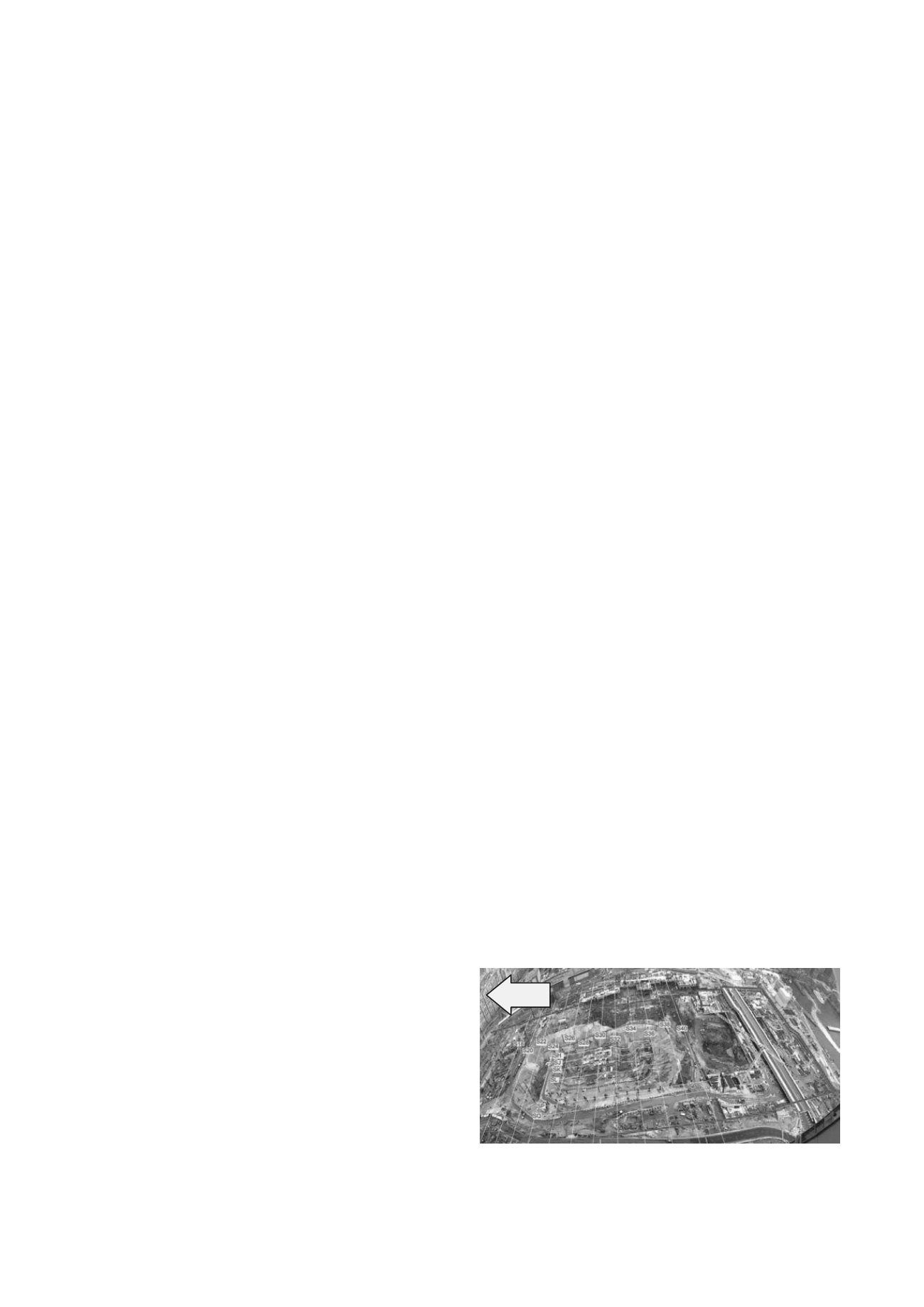
1255
The Use of Jet Grouting to Enhance Stability of Bermed Excavation
L'utilisation de Jet Grouting pour améliorer la stabilité d’une excavation avec risbermes
Cheuk J.C.Y., Lai A.W.L., Cheung C.K.W.
AECOM Asia Co. Ltd., HKSAR, China
Man V.K.W., So A.K.O.
MTR Corporation Ltd., HKSAR, China
ABSTRACT: Jet grouting has been widely used as a ground treatment method to improve the mechanical behaviour of soft soils in
many different types of constructions. This technique has been used to facilitate the construction of the West Kowloon Terminus
(WKT) of the Hong Kong section of the Guangzhou-Shenzhen-Hong Kong Express Rail Link (XRL) in Hong Kong. The construction
sequence of the central portion of the deep excavation involves the formation of temporary cut slopes which serve to partially support
the diaphragm wall until the core station structure is completed. The stability of the temporary cut slopes, hence the excavation, is
affected by the presence of soft marine deposits. Jet grout columns are therefore constructed to enhance the overall stability of the
temporary cut slopes before excavation. The paper discusses the design philosophy of the deep excavation supported by temporary cut
slopes which have been pre-treated by jet grouting. The performance of the jet grout columns have been verified by post-construction
coring together with in-situ and laboratory testing. Results of these verification measures and field monitoring data which demonstrate
the overall performance of the excavation supported by slopes treated by jet grouting are also presented.
RÉSUMÉ : Le jet grouting a été largement utilisé comme une méthode de traitement du sol pour améliorer le comportement
mécanique des sols mous dans de nombreux types de constructions. Cette technique a été utilisée pour faciliter la construction du
Terminus West Kowloon (WKT) de la section située à Hong Kong de la liaison ferroviaire express Guangzhou-Shenzhen-Hong Kong
(XRL). La séquence de la construction de la partie centrale de l'excavation profonde implique la création de talus temporaires qui
servent à supporter partiellement la paroi moulée jusqu'à ce que la structure de la station de base soit terminée. La stabilité des talus
temporaires, et donc de l'excavation, est affectée par la présence de dépôts marins mous. Des colonnes de jet grouting sont donc
réalisées de manière à améliorer la stabilité globale des talus temporaires avant excavation. Cet article traite du concept de
dimensionnement de l'excavation profonde soutenue par des talus temporaires pré-traités par jet grouting. La performance des
colonnes de jet grouting a été vérifiée par un carottage post-construction associé à des essais in-situ et en laboratoire. Les résultats de
ces mesures de vérification et de surveillance des données en place qui démontrent la performance globale de l'excavation soutenue
par des pentes traitées par jet grouting sont également présentés.
KEYWORDS: Deep excavation, slope stability, soil berm, soft clay, diaphragm wall, jet grouting
1 INTRODUCTION
The West Kowloon Terminus (WKT) is the underground
terminus of the Hong Kong section of the Guangzhou-
Shenzhen-Hong Kong Express Rail Link (XRL). The multi-
storey 10-hectare terminus, located at West Kowloon to the
north of the West Kowloon Cultural District (WKCD), will be
linked to the Kowloon Station and Austin Station and is
expected to be commissioned in 2015. The entire station will
be an underground structure with an iconic roof erected above
it.
The construction of the underground terminus involves deep
excavation of about 30m supported by a 1.5m thick reinforced
concrete diaphragm wall. To meet the tight programme, a
construction sequence involving open cut excavation supported
by the diaphragm wall and temporary cut slopes formed in front
of the wall – sometimes referred to as bermed excavation – was
adopted at the central portion of the deep excavation as shown
in Figure 1. The concept of using soil berm as lateral support for
deep excavation can be dated back to 1960s (Peck, 1969).
Various analysis methods have been discussed in Simpson and
Powrie (2001). These methods have also been used to back
analyse centrifuge model tests (e.g. Powrie and Daly, 2002).
The temporary cut slopes serve to provide lateral support to
the diaphragm wall against earth and water pressures. The
stability of the temporary cut slopes, hence the excavation, is
adversely affected by the presence of soft marine deposits
which is overlain by reclamation fill. To enhance overall
stability of the temporary cut slopes and to reduce wall
deflection during excavation, jet grout columns (JGCs) were
constructed before excavation. The construction of jet grout
columns involved the use of a high energy jet of fluid to break
up and loosen the ground, and subsequently replaced the slurry
by cement grout.
This paper discusses the design philosophy of the deep
excavation supported by temporary cut slopes which have been
pre-treated by jet grouting. The performance of the jet grout
columns was verified by post-construction coring together with
in-situ and laboratory testing. Results of these verification
measures are also presented.
N
Figure 1. Deep excavation at West Kowloon Terminus (WKT).


